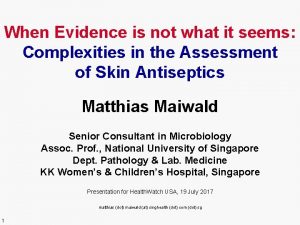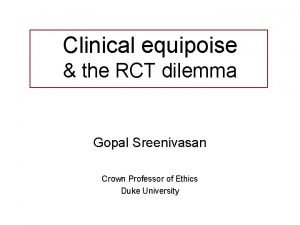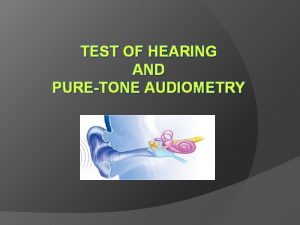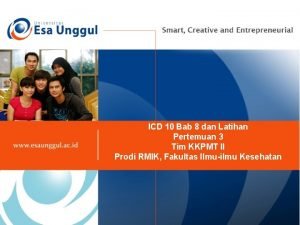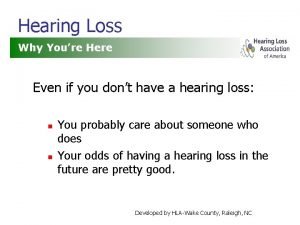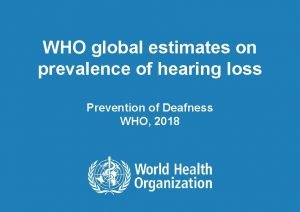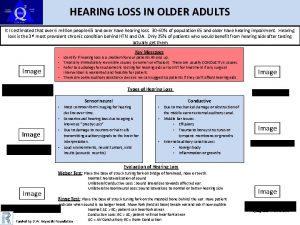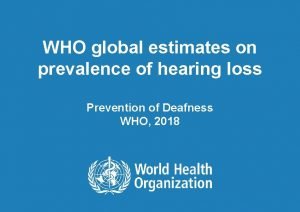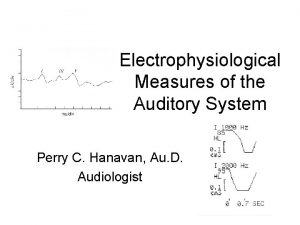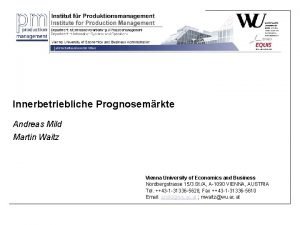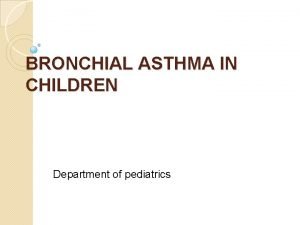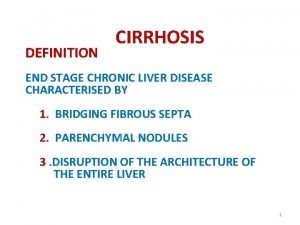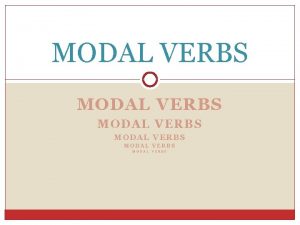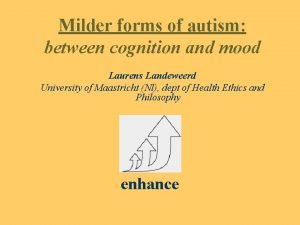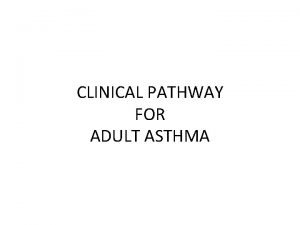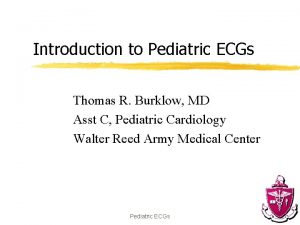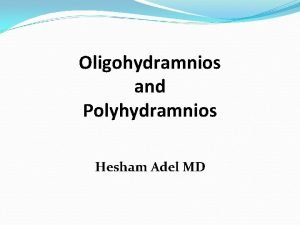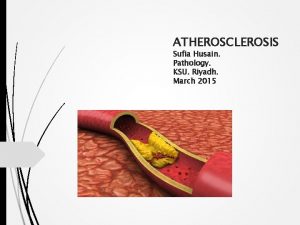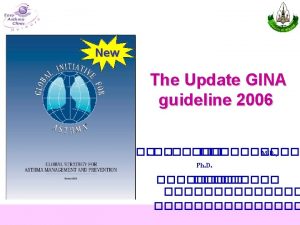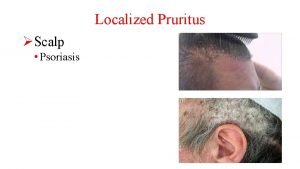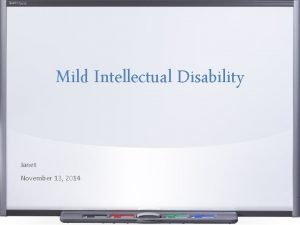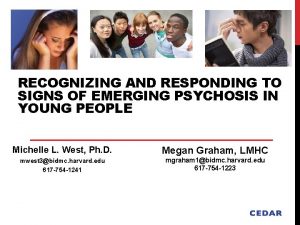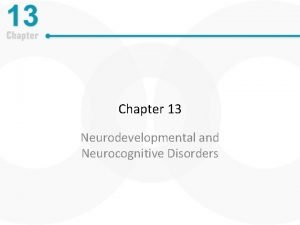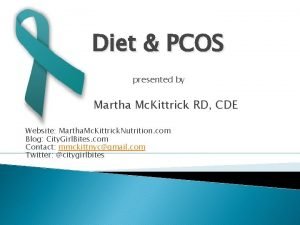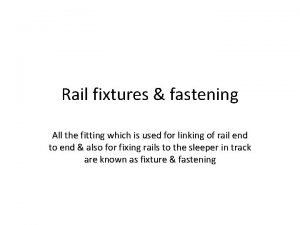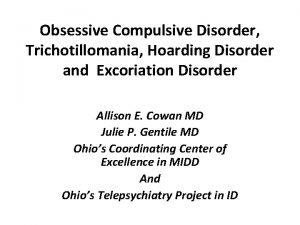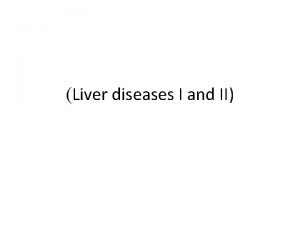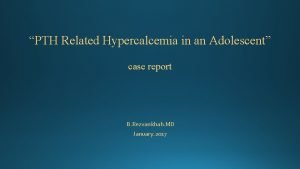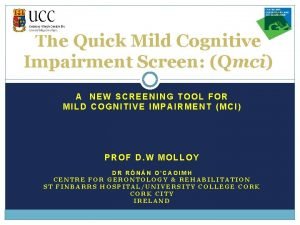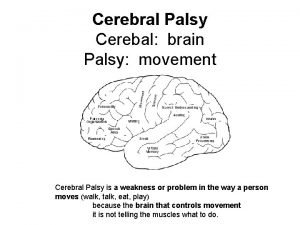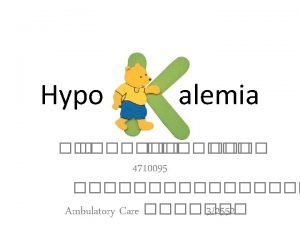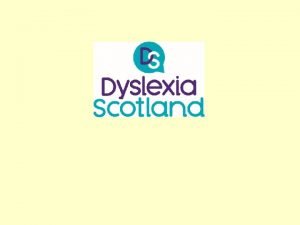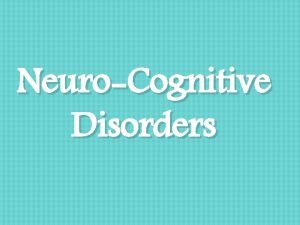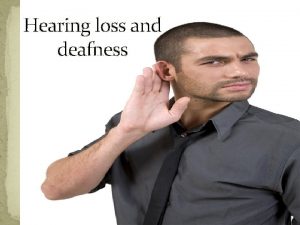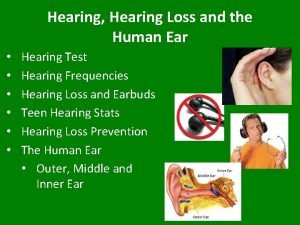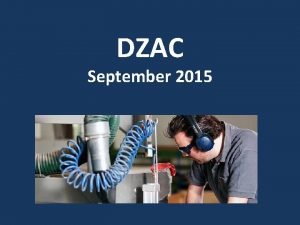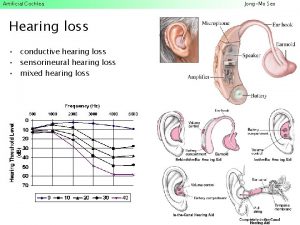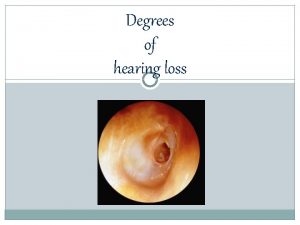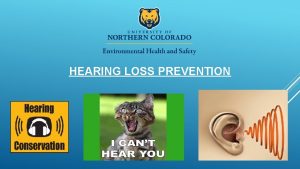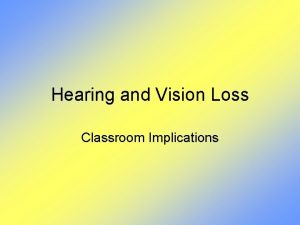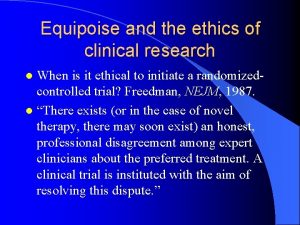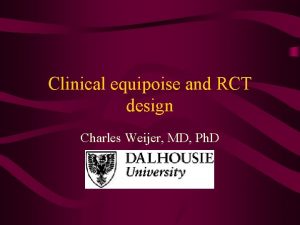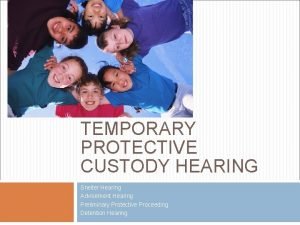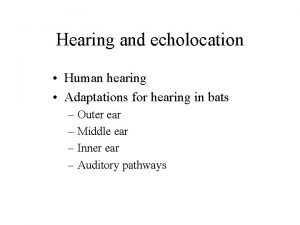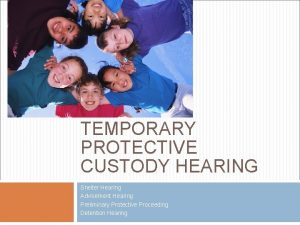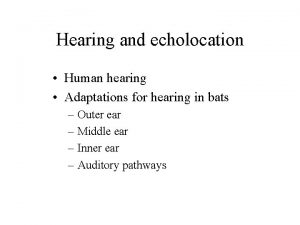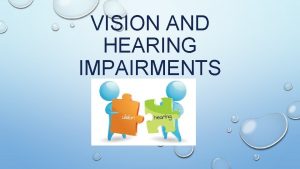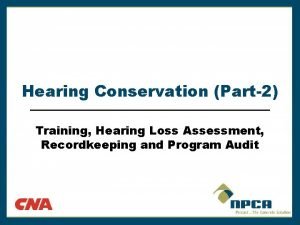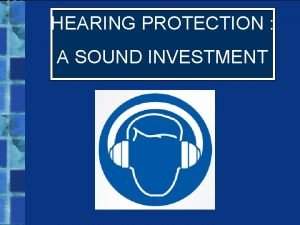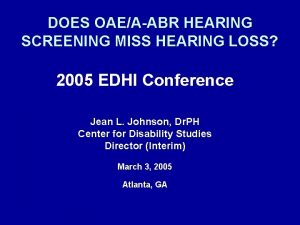Mild hearing loss a case of clinical equipoise

























































- Slides: 57

Mild hearing loss: a case of clinical equipoise Elizabeth Walker, Ph. D, CCC-SLP/A Assistant Professor University of Iowa, Iowa City, IA Supported by NIDCD R 01 DC 009560 OTO GRAND ROUNDS 1

~15% of children ages 6 -19 years have a significant hearing loss 2 40 -50% have mild or unilateral hearing loss (Fitzpatrick et al. , 2010)

Are children with significant amounts of residual hearing at risk? Is intervention (e. g. , hearing aids) warranted? ~15 -40 d. B HL

Children with mild hearing loss present special challenges

Identification and diagnosis • Delays in confirmation • NHS not intended to identify < 35 d. B • Insert earphones calibrated to 2 cc coupler. Sound is louder in an infant ear canal than an adult ear canal. Management • Delays in hearing aid fitting • Lack of consensus on optimal intervention strategies • Not all children show delays • Ambiguity re. HAT or EI will lead to better outcomes

Children with mild HL experience service delays Walker et al, 2016, American Journal of Audiology

Children with mild HL experience delays between confirmation & HA fitting—why? 15 57 Walker et al, 2015, American Journal of Audiology 42 71 85 43 NHS > 45 (n=127) NHS-mild (n=81) 1 month or less 2 months or greater 58 29 Later > 45 Later-mild (n=33) 45 (n=24)

Why are children with mild HL receiving services later? • Terms we use? • It’s “just a mild hearing loss” (Fitzpatrick et al. , 2017)

Simulation ga n n ise no en t am te m ru gi in ad re ec h ct s al ar m to rts st l in nd je ob e fir ng as po ga m us ica go de rs ta Un in ay Pl in ar He ni of ie ts pe Qu ar Le ng es na m di ta n rs de Un ng ni ar Difficulty Term we use to describe loss = parent perception of disability Le “Mild” 7 6 5 4 3 2 1 0 Term Modified from Haggard & Primus 1999 AJA

Why are children with mild HL receiving services later? • Terms we use? • It’s “just a mild hearing loss” (Fitzpatrick et al. , 2017) • Uncertainty about benefit?

Do you think hearing aids help your child hear better? “I don’t know…” • I don’t know, we still have a hard time noticing she has a hearing loss. • He does respond to quieter sounds with the aids on but he is alert with them off too. We need to get better at putting them on. • I know it is necessary, but he is so young and he takes them off a lot. I think it helps and see the value in it. • I don’t know. I can’t tell a big difference. • I cannot say yes or no. It is hard to tell. She responds well without her aids. • He does not always wear his aids. I doubt sometimes that he hears better with them on. He doesn’t like his aids but I make him wear them. • I can’t imagine that they do. He is so young now to know. Walker et al, 2016, American Journal of Audiology

Why are children with mild HL receiving services later? • Terms we use? • It’s “just a mild hearing loss” (Fitzpatrick et al. , 2017) • Uncertainty about benefit? • Inconsistency in evidence base?

Lack of evidence to support intervention for mild HL Carew et al 2017

Situation of “clinical equipoise” regarding management for children with mild hearing loss Current evidence base • Children with mild HL are at risk for delays and difficulties in the academic setting • Bess et al. , 1985; Blair et al. , 1985; Davis et al. , 1981; Dokovic et al. , 2013; Yoshinaga-Itano et al. , 2008; Lewis et al. , 2015 14

BKB sentences Story & comprehension questions +10 d. B SNR 0. 6 s RT Lewis et al. , 2015

Lewis et al. (2015) Ear and Hearing

Situation of “clinical equipoise” regarding management for children with mild hearing loss Current evidence base • Other studies show minimal impact of mild HL on outcomes, with ambiguity re. benefit from hearing aids and early identification and intervention • Porter et al. , 2014; Wake et al. , 2006; Carew et al. , 2017 17

Limitations of past studies • Mild often grouped with unilateral/minimal HL OR moderate to severe/profound • Studies focus on the effects of age at service delivery • Most studies do not describe influence of both aided audibility and amount of daily HA use on outcomes 18


The OCHL study is a multicenter, longitudinal study focusing on outcomes of children with mild-severe hearing loss SUBJECTS TOTAL HH 317 NH 117

Study participants: Inclusion criteria 6 months to 7 years at entry English primary language No major secondary disabilities No cochlear implants Permanent mild to severe bilateral hearing loss

Caveats for OCHL • Socioeconomic status of the sample • Language background – English only Outcomes may appear better than • Additional disabilities - Excluded they would be in the general • Cochlear implants – Only pre-implant data population

How do young children who are hard of hearing compare to children with normal hearing? Group differences… Conclusion: Children who are hard of hearing are at risk for language delays. . . * p <. 0001 Tomblin et al. , Ear & Hearing, 2015 23

Situation of “clinical equipoise” regarding need for intervention and benefits of HAs for children with mild hearing loss Can hearing aids make a difference? 24

Vocabulary Articulation Grammar Phonological processing Speech recognition in noise 25

There were no differences between groups for speech recognition in noise 100 90 Non users (n = 4) 80 Part time (n = 8) Percent correct 70 60 50 40 30 Full time (n = 6) Take home message: Do not rely solely on audiological outcome measures to determine benefit from HAs 20 10 0 Phoneme +10 SNR Phoneme -5 SNR CASPA condition 26 Word +10 SNR Phoneme -5 SNR

What are the implications? Traditional word recognition tests and speech production skills may not be sensitive to individual differences for children with mild hearing loss

What about older children with mild hearing loss?

• Method Higher-level social cognition: Sarcasm • 9 Picture-Supported Stories • de Villiers & de Villiers • Presented in standard audio-visual format • Child answered questions requiring interpretation or reasoning

Results – Understanding Sarcasm at 8 years Main effect of hearing category p =. 004 Sweet Spot?


Results: Literacy and Language at 8 years * * • Children with Moderate -severe HL poorer than children with normal hearing and children with moderate HL in reading comprehension.

Results: Literacy and Language at 8 years * * • Oral language outcomes are similar to reading comprehension.

Results: Literacy and Language at 8 years

What explains the “sweet spot” pattern? • Age at identification/hearing aid fitting/early intervention • Audibility level (i. e. , how much access to the speech spectrum with or without hearing aids) • Consistency of hearing aid use Cumulative auditory experience

What about the influence of auditory access? Audibility Hearing aid use Auditory experience

Audibility: How much access we have to speech sounds • Determined by: • Distance, input level • Hearing thresholds • Aided or unaided • Measured by: • Real ear probe microphone

Audibility across categories

Aided Audibility Contributes to Language GROWTH • Quartiles of Aided Benefit, after controlling for degree of loss • Benefit holds for mild to severe degrees of HL Take home message: Children with optimally fit HAs show steeper growth in language skills Tomblin, Harrison, Ambrose, Walker, Oleson, & Moeller, E&H (2015); Mc. Creery et al. , E &H (2015) 39

What about the influence of auditory access? Audibility Hearing aid use Auditory experience

What we know about HA use • At-risk for low use: • Younger age • Mild HL • Low SES Walker, et al. , 2013

Consistent HA Use Benefits Growth Conclusion: Children who wear HAs more than 10 hours/day show steeper growth in language skills than children wearing HAs less than 10 hours/day Tomblin et al. , E&H (2015) 42

What if we combine aided SII with HA use? Aided. Hrs. Aided. SII – Unaided. Hrs. Unaided. SII = HA Dosage HA Hours Aided SII Hours Unaided SII dose 16 0. 75 8 0. 25 6. 32 12 0. 75 12 0. 25 4. 59 8 0. 75 16 0. 25 2. 76 4 0. 75 20 0. 25 0. 71 Walker et al, 2020


Does Hearing Aid dosage explain outcomes? HA Dosage = Aided. Hrs. Aided. SII – Unaided. Hrs. Unaided. SII Hearing Aid Dosage Walker et al, accepted

Yes! More benefit from HA use when unaided SII less than ~80% Significant interaction between unaided SII and Hearing Aid Dosage Walker et al, accepted

Conclusions: Implications for hearing aid candidacy Children with mild hearing loss (specifically with unaided SII >80%) don’t show increased benefit from hearing aids. Children with mild hearing loss (specifically with unaided SII <80%) are at risk for delays in language acquisition without hearing aids.

Conclusions: Implications for counseling • Diagnostic Audiologist and ENT can discuss: • Audibility and why it is important for language (explain hearing loss in percentage) • How even small disruptions in audibility can affect communication

Want to learn more?


Future directions in research: • NIH/NIDCD R 01 Finding Appropriate Solutions to Treat Reduced Audibility in Kids (FASTRAK) • Funding began 7/2020 • Aim 1: Develop audibility-based hearing aid candidacy tools for children with mild hearing loss • Aim 2: Validate clinical measures of speech recognition with speech maskers, reverberation, and overhearing that reflect the difficulties encountered by children with mild hearing loss • Aim 3: Clinical validation of hearing aid candidacy and outcome measures for children with mild hearing loss

This Photo by Unknown Author is licensed under CC BY-SA Coming soon… This Photo by Unknown Author is licensed under CC BY-SA FASTRAK

FASTRAK

• Elizabeth-Walker@uiowa. edu • www. ochlstudy. org Free access to OCHL supplement in Ear & Hearing

Like us on Facebook and Instagram!

Questions? Special thanks to the families and children who have faithfully participated in these studies! 56

Questions? 57
 Clinical equipoise
Clinical equipoise Aishwarya sreenivasan
Aishwarya sreenivasan Sound test
Sound test Penurunan pendengaran icd 10
Penurunan pendengaran icd 10 Schwabach test results
Schwabach test results Cookie bite hearing loss
Cookie bite hearing loss Who global estimates on prevalence of hearing loss 2020
Who global estimates on prevalence of hearing loss 2020 Conductive hearing loss lateralization
Conductive hearing loss lateralization Who global estimates on prevalence of hearing loss 2020
Who global estimates on prevalence of hearing loss 2020 Tympanogram as type
Tympanogram as type The method of unit costing is adopted by
The method of unit costing is adopted by Best worst and average case
Best worst and average case None mild moderate severe
None mild moderate severe Andreas mild
Andreas mild Mild moderate severe asthma exacerbation
Mild moderate severe asthma exacerbation Hydrometra uterus
Hydrometra uterus Bending stress of mild steel
Bending stress of mild steel Chronic liver desease
Chronic liver desease Mild obligation
Mild obligation Mild steel example
Mild steel example Mild autism
Mild autism Chylous ascites
Chylous ascites Asthma clinical pathway
Asthma clinical pathway Mild environment definition
Mild environment definition Primary aldehyde
Primary aldehyde Ascitic fluid examination
Ascitic fluid examination Short pr intervals
Short pr intervals Oligohydramnios
Oligohydramnios Atherosclerosis
Atherosclerosis Types of dehydration
Types of dehydration Classification of asthma severity
Classification of asthma severity Mild kognitiv svikt
Mild kognitiv svikt Mild scalp psoriasis pictures
Mild scalp psoriasis pictures Mild intellectual disability
Mild intellectual disability Mild psychosis
Mild psychosis Maternal causes of polyhydramnios
Maternal causes of polyhydramnios Seltzer water and all sodas contain a very mild
Seltzer water and all sodas contain a very mild Major vs mild neurocognitive disorder
Major vs mild neurocognitive disorder Asthma classification chart
Asthma classification chart Mild hirsutism pictures
Mild hirsutism pictures Types of fixtures and fastenings in railway
Types of fixtures and fastenings in railway Icd 10 seasonal allergies
Icd 10 seasonal allergies Autism vs ocd
Autism vs ocd Mild moderate severe asthma exacerbation
Mild moderate severe asthma exacerbation Is sir capitalized
Is sir capitalized Flame hardening steel
Flame hardening steel Informal letter of complaint
Informal letter of complaint Mild hepatic steatosis
Mild hepatic steatosis Familial hypocalciuric hypercalcemia
Familial hypocalciuric hypercalcemia Qmci
Qmci Cerebal
Cerebal Potassium dose calculation
Potassium dose calculation Metal categories
Metal categories Hypertonic dehydration
Hypertonic dehydration Hybrid
Hybrid Is there mild dyslexia
Is there mild dyslexia Remiryl
Remiryl Mild foreign-body airway obstruction
Mild foreign-body airway obstruction
